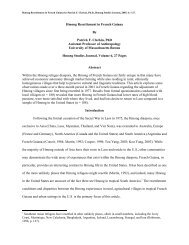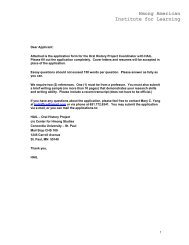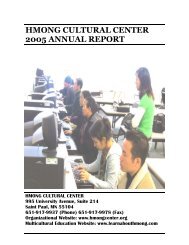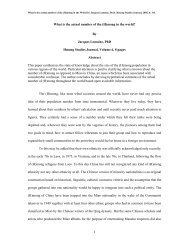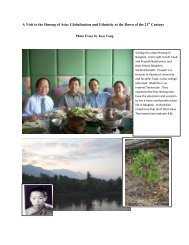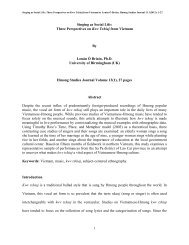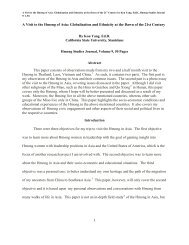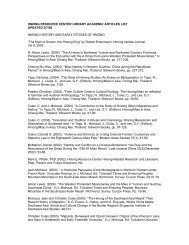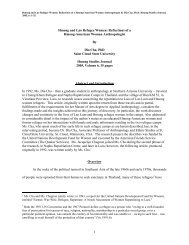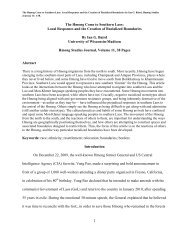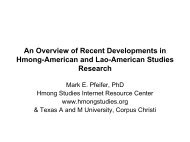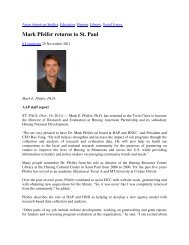Research Notes from the Field - Hmong Studies Internet Resource ...
Research Notes from the Field - Hmong Studies Internet Resource ...
Research Notes from the Field - Hmong Studies Internet Resource ...
Create successful ePaper yourself
Turn your PDF publications into a flip-book with our unique Google optimized e-Paper software.
<strong>Research</strong> <strong>Notes</strong> <strong>from</strong> <strong>the</strong> <strong>Field</strong>:Tracing <strong>the</strong> Path of <strong>the</strong> Ancestors – A Visit to <strong>the</strong> <strong>Hmong</strong> in China by Kou Yang, EdD,<br />
<strong>Hmong</strong> <strong>Studies</strong> Journal, 2005, 6: 1-38.<br />
Since 1975, <strong>the</strong> <strong>Hmong</strong> living outside of China have been continuously visiting China and <strong>the</strong> Miao<br />
residing <strong>the</strong>re. In 1975, Dr. Yang Dao visited China as a member of a delegation of <strong>the</strong> Provisionary<br />
Coalition Government of Laos. He met with a few Miao in Beijing, but was not a guest of <strong>the</strong> Miao in China.<br />
In 1986-87, Kou Yang spent six months studying, teaching, and traveling in many parts of China as an<br />
exchange student and teacher. He spent <strong>the</strong> last two weeks of his visit with <strong>the</strong> Miao in Yunnan and Guangxi.<br />
This was <strong>the</strong> first time a <strong>Hmong</strong> living outside of China came to study and teach in China, taking time to<br />
learn more about <strong>the</strong> Miao <strong>the</strong>re. After Kou Yang returned to <strong>the</strong> United States with news about <strong>the</strong> Miao in<br />
China, he published an article about his visit in Haiv <strong>Hmong</strong>, a magazine published in <strong>the</strong> <strong>Hmong</strong> language.<br />
As a result of this and China’s open door policy, many <strong>Hmong</strong> Americans began to learn about <strong>the</strong>ir cousins<br />
in China and started to visit China. As China became more open in <strong>the</strong> late 1980s, <strong>the</strong> Miao in China were at<br />
liberty to contact <strong>the</strong> <strong>Hmong</strong> in <strong>the</strong> West and more <strong>Hmong</strong> Americans and <strong>Hmong</strong> French were able to visit<br />
China. The visit of <strong>Hmong</strong> Americans to China during <strong>the</strong> late 1980s was still very limited. Only a few<br />
<strong>Hmong</strong> individuals and groups visited <strong>the</strong> <strong>Hmong</strong> in China and <strong>the</strong>ir visits tended to be limited to <strong>the</strong> <strong>Hmong</strong><br />
in Kunming and Wenshan in Yunnan. A more significant visit came in <strong>the</strong> 1988, when <strong>the</strong> Miao in Beijing<br />
invited Dr. Yang Dao and his delegation (among which this author was a member) to visit <strong>the</strong>m in Beijing<br />
and Yunnan and Guizhou. They also invited ano<strong>the</strong>r delegation <strong>from</strong> France. This marked <strong>the</strong> first time <strong>the</strong><br />
Miao in China were officially hosts of <strong>the</strong>ir <strong>Hmong</strong> cousins <strong>from</strong> overseas. At <strong>the</strong> Beijing International<br />
Airport, a group of Miao professors and students held a sign welcoming <strong>the</strong> <strong>Hmong</strong> <strong>from</strong> America. This visit<br />
is what expanded <strong>the</strong> bridge between <strong>the</strong> Miao in China<br />
and <strong>the</strong> <strong>Hmong</strong> in <strong>the</strong> United States, and it broadened knowledge and mutual understanding between <strong>the</strong>m.<br />
Following this visit, more <strong>Hmong</strong> Americans went to China, and many young <strong>Hmong</strong> Americans married<br />
young Miao Chinese and brought <strong>the</strong>ir spouses to <strong>the</strong> United States.<br />
Subsequently, some Miao in Yunnan, China began to visit <strong>the</strong> United States by sending musicians<br />
and singers to <strong>the</strong> <strong>Hmong</strong> American New Year during <strong>the</strong> 1990s. Many <strong>Hmong</strong> individuals and groups also<br />
visited China and attended <strong>the</strong> Miao New Year and conferences. A few of <strong>the</strong>m also went <strong>the</strong>re to explore<br />
business opportunities. A few o<strong>the</strong>r <strong>Hmong</strong> American visitors made videos about <strong>the</strong> <strong>Hmong</strong> in China and<br />
marketed <strong>the</strong>ir videos to <strong>the</strong> <strong>Hmong</strong> in <strong>the</strong> west. As <strong>the</strong> relationship among <strong>the</strong> people of <strong>the</strong> two countries<br />
became stronger, numerous incidents of misunderstanding and cultural clashes also surfaced. The<br />
author of this essay and several friends visited China in 1993, and were guests of <strong>the</strong> 30 th Anniversary of <strong>the</strong><br />
proclamation of Pingpian County as “Miao Autonomous County.” Pingpian County is in <strong>the</strong> Honghe region,<br />
6




